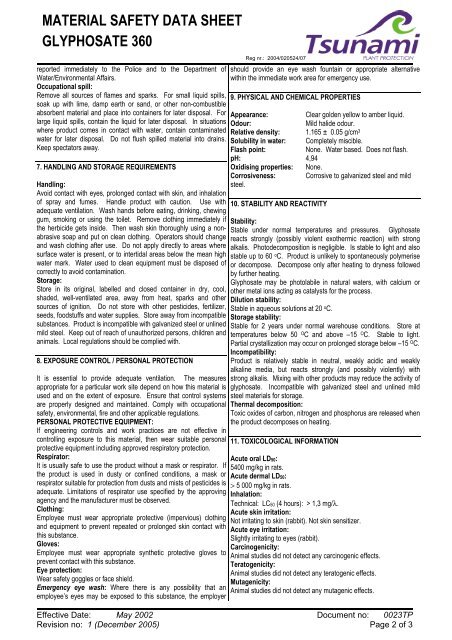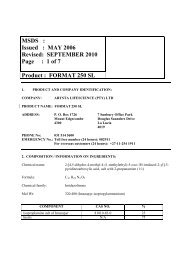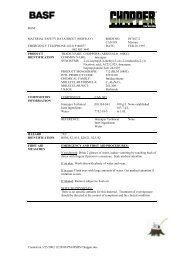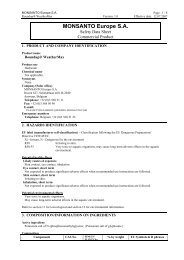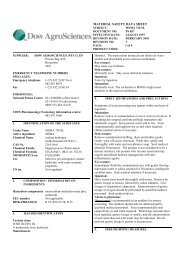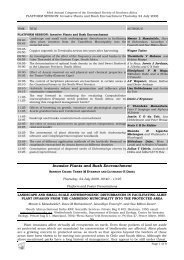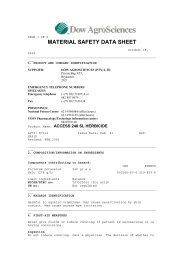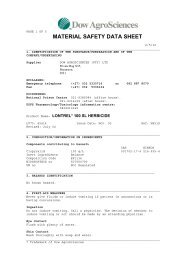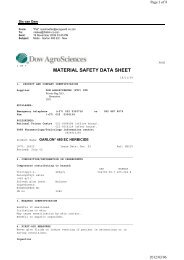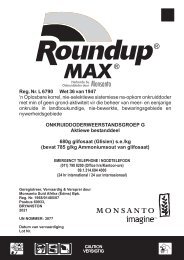MSDS Glyphosate 360 - Bush Encroachment
MSDS Glyphosate 360 - Bush Encroachment
MSDS Glyphosate 360 - Bush Encroachment
You also want an ePaper? Increase the reach of your titles
YUMPU automatically turns print PDFs into web optimized ePapers that Google loves.
MATERIAL SAFETY DATA SHEET<br />
GLYPHOSATE <strong>360</strong><br />
reported immediately to the Police and to the Department of<br />
Water/Environmental Affairs.<br />
Occupational spill:<br />
Remove all sources of flames and sparks. For small liquid spills,<br />
soak up with lime, damp earth or sand, or other non-combustible<br />
absorbent material and place into containers for later disposal. For<br />
large liquid spills, contain the liquid for later disposal. In situations<br />
where product comes in contact with water, contain contaminated<br />
water for later disposal. Do not flush spilled material into drains.<br />
Keep spectators away.<br />
7. HANDLING AND STORAGE REQUIREMENTS<br />
Handling:<br />
Avoid contact with eyes, prolonged contact with skin, and inhalation<br />
of spray and fumes. Handle product with caution. Use with<br />
adequate ventilation. Wash hands before eating, drinking, chewing<br />
gum, smoking or using the toilet. Remove clothing immediately if<br />
the herbicide gets inside. Then wash skin thoroughly using a nonabrasive<br />
soap and put on clean clothing. Operators should change<br />
and wash clothing after use. Do not apply directly to areas where<br />
surface water is present, or to intertidal areas below the mean high<br />
water mark. Water used to clean equipment must be disposed of<br />
correctly to avoid contamination.<br />
Storage:<br />
Store in its original, labelled and closed container in dry, cool,<br />
shaded, well-ventilated area, away from heat, sparks and other<br />
sources of ignition. Do not store with other pesticides, fertilizer,<br />
seeds, foodstuffs and water supplies. Store away from incompatible<br />
substances. Product is incompatible with galvanized steel or unlined<br />
mild steel. Keep out of reach of unauthorized persons, children and<br />
animals. Local regulations should be complied with.<br />
8. EXPOSURE CONTROL / PERSONAL PROTECTION<br />
It is essential to provide adequate ventilation. The measures<br />
appropriate for a particular work site depend on how this material is<br />
used and on the extent of exposure. Ensure that control systems<br />
are properly designed and maintained. Comply with occupational<br />
safety, environmental, fire and other applicable regulations.<br />
PERSONAL PROTECTIVE EQUIPMENT:<br />
If engineering controls and work practices are not effective in<br />
controlling exposure to this material, then wear suitable personal<br />
protective equipment including approved respiratory protection.<br />
Respirator:<br />
It is usually safe to use the product without a mask or respirator. If<br />
the product is used in dusty or confined conditions, a mask or<br />
respirator suitable for protection from dusts and mists of pesticides is<br />
adequate. Limitations of respirator use specified by the approving<br />
agency and the manufacturer must be observed.<br />
Clothing:<br />
Employee must wear appropriate protective (impervious) clothing<br />
and equipment to prevent repeated or prolonged skin contact with<br />
this substance.<br />
Gloves:<br />
Employee must wear appropriate synthetic protective gloves to<br />
prevent contact with this substance.<br />
Eye protection:<br />
Wear safety goggles or face shield.<br />
Emergency eye wash: Where there is any possibility that an<br />
employee’s eyes may be exposed to this substance, the employer<br />
Reg nr.: 2004/020524/07<br />
should provide an eye wash fountain or appropriate alternative<br />
within the immediate work area for emergency use.<br />
9. PHYSICAL AND CHEMICAL PROPERTIES<br />
Appearance: Clear golden yellow to amber liquid.<br />
Odour:<br />
Mild halide odour.<br />
Relative density: 1.165 ± 0.05 g/cm 3<br />
Solubility in water: Completely miscible.<br />
Flash point:<br />
None. Water based. Does not flash.<br />
pH: 4,94<br />
Oxidising properties: None.<br />
Corrosiveness: Corrosive to galvanized steel and mild<br />
steel.<br />
10. STABILITY AND REACTIVITY<br />
Stability:<br />
Stable under normal temperatures and pressures. <strong>Glyphosate</strong><br />
reacts strongly (possibly violent exothermic reaction) with strong<br />
alkalis. Photodecomposition is negligible. Is stable to light and also<br />
stable up to 60 o C. Product is unlikely to spontaneously polymerise<br />
or decompose. Decompose only after heating to dryness followed<br />
by further heating.<br />
<strong>Glyphosate</strong> may be photolabile in natural waters, with calcium or<br />
other metal ions acting as catalysts for the process.<br />
Dilution stability:<br />
Stable in aqueous solutions at 20 o C.<br />
Storage stability:<br />
Stable for 2 years under normal warehouse conditions. Store at<br />
temperatures below 50 O C and above –15 O C. Stable to light.<br />
Partial crystallization may occur on prolonged storage below –15 O C.<br />
Incompatibility:<br />
Product is relatively stable in neutral, weakly acidic and weakly<br />
alkaline media, but reacts strongly (and possibly violently) with<br />
strong alkalis. Mixing with other products may reduce the activity of<br />
glyphosate. Incompatible with galvanized steel and unlined mild<br />
steel materials for storage.<br />
Thermal decomposition:<br />
Toxic oxides of carbon, nitrogen and phosphorus are released when<br />
the product decomposes on heating.<br />
11. TOXICOLOGICAL INFORMATION<br />
Acute oral LD50:<br />
5400 mg/kg in rats.<br />
Acute dermal LD50:<br />
> 5 000 mg/kg in rats.<br />
Inhalation:<br />
Technical: LC50 (4 hours): > 1,3 mg/λ.<br />
Acute skin irritation:<br />
Not irritating to skin (rabbit). Not skin sensitizer.<br />
Acute eye irritation:<br />
Slightly irritating to eyes (rabbit).<br />
Carcinogenicity:<br />
Animal studies did not detect any carcinogenic effects.<br />
Teratogenicity:<br />
Animal studies did not detect any teratogenic effects.<br />
Mutagenicity:<br />
Animal studies did not detect any mutagenic effects.<br />
Effective Date: May 2002 Document no: 0023TP<br />
Revision no: 1 (December 2005) Page 2 of 3


